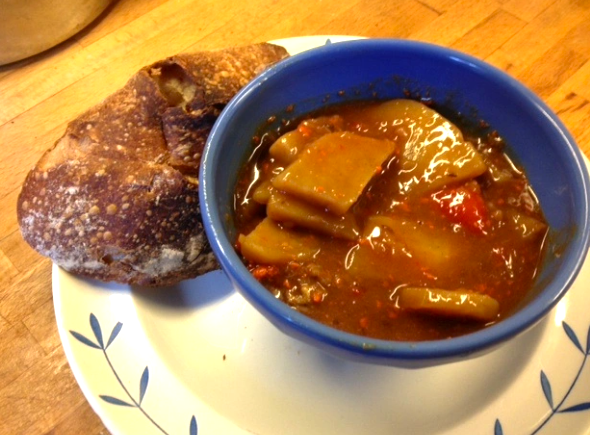The sun was shining this morning, but the thermometer showed 6 degrees F. As the world came hesitantly into focus while I crawled out of bed, my brain posted its usual a.m. orientation notes, reminding me that the father of a friend passed away yesterday (he was a fine man, and lived a long and eventful life) — and wouldn’t soup taste good right about now?
But wait, hadn’t I just recently read an article about all this? Yes, I had. In fact, I’d bookmarked it: Comfort Food, at Finom – The Food of Hungary website.
My father expressed his emotions with food. He was the cook in our family, until I was old enough to take over. The dish he made most often was the Hungarian classic, gulyásleves or goulash soup. When he died, I made cauldrons of gulyás to feed the visitors that came from Hungary and other cities to his funeral. We ate it by the bowlful, salted with our tears, and missing him beyond expressing. I still make gulyás, and it transports me straight back to childhood. Sitting in the darkening kitchen, spooning up the rust coloured broth and wondering if Mum was going to get up that day.
Goulash (as we Americans call it) comes in differing modes of presentation in Central Europe, much as chili does here.
In Hungary, the word leves signifies soup, as with the recipe for Antal Gulyás provided in the essay, which also is a rumination about the intertwining of food and grief. After all, “comfort” is what we seek to offer to the distressed in times of need, and throughout human history, breaking bread communally serves to reinforce the bonds we continue to share while mourning the absence of the departed.
I’d make this recipe today, except the pantry is lacking ingredients — and did I mention it’s cold outside? No sense in driving to the store. The gulyás can wait for another day. For now, it’s eggs and potatoes, and a day for thinking about Paul’s family.
Maybe later, a touch of the brown water, and a toast to a life well lived. He’d appreciate that, and probably suggest I smoke a cigar, too, but seeing as I don’t puff indoors, maybe later in the week when it’s warmer outside.
Photo credit: The referenced article.























